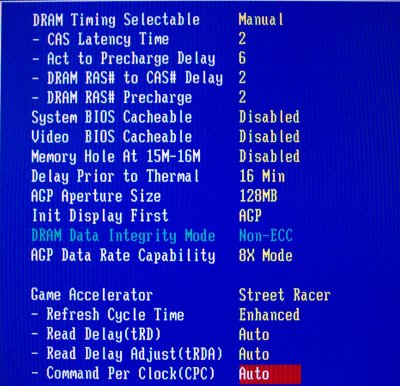BIOS
ABIT's Softmenu is based upon a tweaked Phoenix AwardBIOS.

We're sure that many an enthusiast has seen this screen before, usually when trying to overclock the CPU and/or memory.

Voltages and settings are covered in the standard Softmenu setup screen. User Defined is the way to go if you know what you're doing. We expect potential buyers of this board to be au fait with the basics of overclocking and tweaking. There's little reason to shell out almost £200 if you want to run at stock speeds, is there?. Our test 3.2GHz is semi-unlocked from 12x - 16x, that's why the multiplier section is open. The Ext. Clock encompasses a number of ratios that are best left fixed (relative to each other). FSB speeds run from 100MHz through to an improbable 412MHz, all in stepless increments and all immediately available by keying in the required FSB speed; just what we like. DRAM ratios depend upon just which CPU is in the socket at the time. As 800FSB CPUs are most likely to be used in this enthusiast-orientated board, the options are either SPD, 1:1, 5:4, or 3:2. The ratios define the memory speed relative to the CPU FSB. A 'Fixed' frequency is preferable and, once chosen, allows the user to fix the AGP and PCI speeds (half of AGP) at anything between 66 and 99MHz.
Voltage-wise, enthusiasts will be happy. The CPU gets up to a vigorous 1.925v, DDR sees a blistering 3.2v and AGP voltage is more reserved at up to 1.65v. The older system, where one could set the minimum CPU voltage down to ~1.1v, would have been nice. The sample board tended to undervolt the CPU by up to 0.05v when placed under heavy load. DDR memory voltage, though, appeared to give a little more than was required. A quirky aspect was a popup detailing the dangers of DDR voltage, in Engrish (sic), once 3v+ had been selected. No such warning were present for high CPU voltage, which is more worrying.

Manufacturers often have two methods of increasing board speed relative to competing companies'. You can artificially increase the speed by specifying a higher FSB than normal. ASUS has often been guilty of this. The other more commendable method is to have a super-aggressive BIOS that maximises the potential of components. The standard 2-6-2-2 timings are in evidence here; that's what we use in each and every motherboard benchmarking setup. The Game Accelerator options, however, are relatively new. Setting them to various stringent levels increases performance at the cost of potential stability. The first option is given names that belong to professional car racing. Options are Turbo, Street Racer and F1. The idea is that each more stringent setting extracts the last possible ounce of performance from a i875P chipset. The best we could do with some proven Corsair XMS3500C2 was DDR400 speeds with Street Racer and Enhanced settings. You'll see what difference, if any, it makes on our gamut of benchmarks.


Options and features everywhere, whether it be on-chip or PCI based. The ICH5R's SATA and PATA connections are managed in a separate screen that may require a re-read of the manual. The options allow one to mix and match both PATA and SATA, as well as manage the RAID options. As mentioned before, the Sil3114 SATA options are toggled in a pre-OS screen. The necessary pre-OS and OS drivers are included, naturally.

A comprehensive monitoring section is an absolute must if running components out of specification is your wont. The CPU FanEQ has settings for 60%, 70%, 80%, and 90%, as well as disabled. Setting, for example, 60%, reduces the fans' speeds to the chosen percentage of the original, uncontrolled speed. It affects all three fans listed above so use it with caution. It should work well for a stock system. Lot of flexibility, a decent level of voltage regulation, a number of useful features and a good monitoring section make this one of the better BIOSes around.









